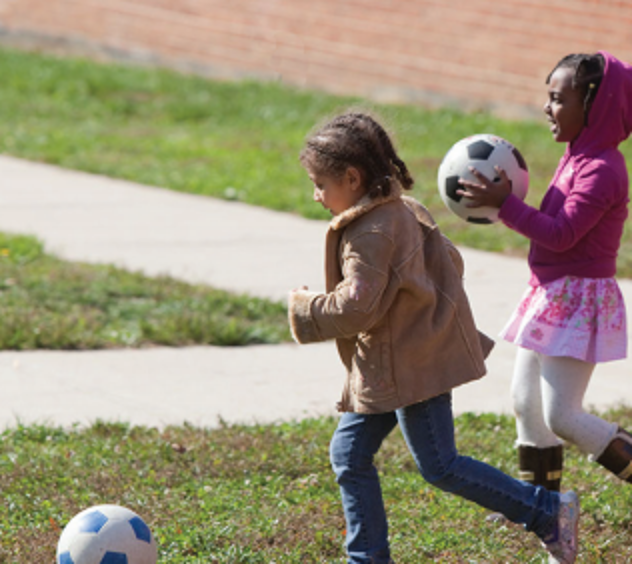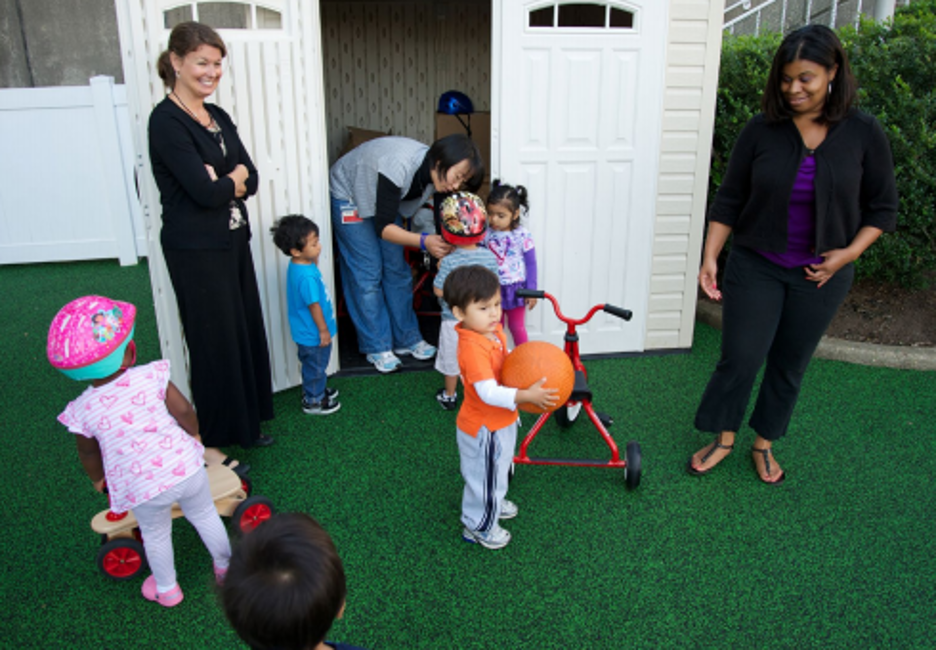Module 6.1 Supporting Physical Activity
Learning Objectives
By the end of this module, you should be able to:
- Discuss physical activity recommendations for young children.
Physical Activity
Good activity habits begin early in children’s lives. As early as infancy, adults can help children grow lifelong healthy play habits. Children learn from adults, they should model being active and participate with children when possible.
Childhood and adolescence are critical periods for developing movement skills, learning healthy habits, and establishing a firm foundation for lifelong health and well-being. Regular physical activity in children and adolescents promotes health and fitness. Compared to those who are inactive, physically active youth have higher levels of cardiorespiratory fitness and stronger muscles. They also typically have lower body fat and stronger bones. Physical activity also has brain health benefits for school-aged children, including improved cognition and reduced symptoms of depression. Evidence indicates that both acute bouts and regular moderate-to-vigorous physical activity improve the cognitive functions of memory, executive function, processing speed, attention, and academic performance for these children.
Youth who are regularly active also have a better chance of a healthy adulthood. Children and adolescents do not usually develop chronic diseases, such as heart disease, hypertension, type 2 diabetes, or osteoporosis. However, current evidence shows that obesity and other risk factors for these diseases, such as elevated insulin, blood lipids, and blood pressure, are increasingly appearing in children and adolescents. Exercise training in youth with overweight or obesity can improve body composition by reducing overall levels of body fat as well as abdominal fat. Regular physical activity also makes it less likely that these risk factors will develop and more likely that children remain healthy when they become adults.

Infants should spend a lot of time on the floor (and out of equipment that limits mobility). This time allows them to reach, and kick so they can reach important milestones like crawling and sitting up.
Toddlers need environments that support movement and activity and intentional opportunities to be physically active. Things like dancing, jumping, and taking walks are great ways to keep them moving.
Preschool-aged children (ages 3 through 5 years) should be encouraged to move and engage in active play as well as in structured activities, such as throwing games and bicycle or tricycle riding. To strengthen bones, young children should do activities that involve hopping, skipping, jumping, and tumbling. Although the specific amount of activity needed to improve bone health and avoid excess fat in young children is not well defined, a reasonable target may be 3 hours per day of activity of all intensities: light, moderate, or vigorous intensity. This is the average amount of activity observed among children of this age and is consistent with guidelines from Canada, the United Kingdom, and the Commonwealth of Australia.
School-aged youth (ages 6 through 17 years) can achieve substantial health benefits by doing moderate and vigorous-intensity physical activity for periods of time that add up to 60 minutes or more each day. This activity should include aerobic activity as well as age-appropriate muscle- and bone-strengthening activities. It appears that, as in adults, the total amount of physical activity is more important for achieving health benefits than is any one component (frequency, intensity, or duration) or specific mix of activities (aerobic, muscle strengthening, bone strengthening).
Children and adolescents should meet the key guidelines by doing activities that are appropriate for their age. Their natural patterns of movement differ from those of adults. For example, children are naturally active in an intermittent way, particularly when they do unstructured active play. During recess and in their free play and games, children use basic aerobic and bone-strengthening activities, such as running, hopping, skipping, and jumping, to develop movement patterns and skills. They alternate brief periods of moderate- and vigorous intensity activity with periods of light-intensity physical activity or rest. Any episode of moderate- or vigorous intensity physical activity, however brief, counts toward the key guidelines for children and adolescents ages 6 through 17 years. For preschool-aged children, activity of any intensity counts, including light intensity.
The Canadian Society for Exercise Physiology (CSEP) has created 24-Hour Movement Guidelines based on age: infants under 1 year, toddlers aged 1-2 years, preschoolers aged 3-4 years and children and youth aged 5-17 years. The Guidelines for infants, toddlers and preschoolers make recommendations for movement, high-quality sedentary activities, and sleep. For example, toddlers should be spending at least 180 minutes per day in a variety of physical activities and should be getting 11-14 hours of sleep (including naps). The Guidelines for children and youth aged 5-17 years make recommendations for moderate to vigorous activity, light physical activity, sedentary behavior, and sleep. For example, children and youth in this age range should accumulate at least 60 minutes per day of moderate to vigorous physical activity and no more than 2 hours of recreational screen time per day. To see the complete set of Guidelines, go to 24-Hour Movement Guidelines.
Traditional activities are a way to be physically active. These have wholistic aspects which are grounded in culture and diverse Indigenous ways of knowing. Some include dancing, bone and stick games, fishing, hunting and gathering, and canoeing. (IPACC, 2023)
Pause to Reflect 💭
What were some of your favourite physical activities as a child? Why did you enjoy these? Are they included in Table 6.1?
Do you still participate in a form of this activity?
Table 6.1 – Examples of Physical Activities for Children
| Type of Physical Activity | Preschool-Aged Children | School-Aged Children |
| Moderate-Intensity Aerobic |
|
|
| Vigorous-Intensity Aerobic |
|
|
| Muscle Strengthening |
|
|
| Bone Strengthening |
|
|

One practical strategy to promote activity in children is to replace sedentary behaviour with activity whenever possible. For example, where appropriate and safe, families should walk or bicycle to school or the bus stop instead of riding in a car. Rather than only watching sporting events on television, children should participate in age-appropriate sports or games.
- Children who do not meet the key guidelines should slowly increase their moderate-to-vigorous physical activity in small steps and in ways that they enjoy. A gradual increase in the number of days and the time spent being active will help reduce the risk of injury.
- Children who meet the key guidelines should continue doing moderate-to-vigorous physical activity every day and, if appropriate, become even more active. Evidence suggests that even more than 60 minutes of activity daily may provide additional health benefits for school-aged youth.
- Children who exceed the key guidelines should maintain their activity level and vary the kinds of activities they do to reduce the risk of overtraining or injury.
Children with disabilities are more likely to be inactive than those without disabilities. Families of children with disabilities should work with a health care professional or physical activity specialist to understand the types and amounts of physical activity appropriate for them. When possible, children with disabilities should meet the key guidelines. When they are not able to participate in the appropriate types or amounts of physical activities needed to meet the key guidelines, they should be as active as possible and avoid being inactive.
Engaging Families in Their Children’s Physical Activity
Share the CSEP recommendations with families with these tips:
- Children under 6 need to be active naturally!
- Aim to keep them moving 3 hours a day — and more is better!
- Limit time when they’re just sitting around (like screen time)
- Children and teens ages 6 to 17 need at least 60 minutes every day. Most of it can be moderate-intensity aerobic activity. Anything that gets their heart beating faster counts. At least three days a week, encourage your kids to step it up to vigorous-intensity aerobic activity.
- Use the “talk test” to find out if activity is moderate or vigorous. When you’re being active, try talking:
- If you’re breathing hard but can still have a conversation easily, it’s moderate-intensity activity.
- If you can only say a few words before you must take a breath, it’s vigorous intensity activity.
- As part of their daily 60 minutes, children and teens also need:
- Muscle-strengthening activity At least 3 days a week; anything that makes their muscles work harder counts — like climbing or swinging on the monkey bars.
- Bone-strengthening activity At least 3 days a week; bones need pressure to get stronger. Running, jumping, and other weight-bearing activities all count.
- Use the “talk test” to find out if activity is moderate or vigorous. When you’re being active, try talking:
- Some ideas:
- Encourage active play with friends.
- Get them involved in active chores.
- Sign them up for free or low-cost sports or classes.
- Take walks.
Important Things to Remember
- Good activity habits begin early in children’s lives.
- Children learn from adults, they should model being active and participate with children when possible.
- Evidence indicates that both acute bouts and regular moderate-to-vigorous physical activity improve the cognitive functions of memory, executive function, processing speed, attention, and academic performance.
Resources for Further Exploration
Early Years: Ages 0-4 (Participaction)
Children and Youth: Ages 5-17 (Participaction)
Physical Activity Tips for Children 5-11 years (Government of Canada)
References
- The Indigenous Physical Activity and Cultural Circle (IPACC). (2023). Government of British Columbia. https://iactive.ca/traditional-activities/

